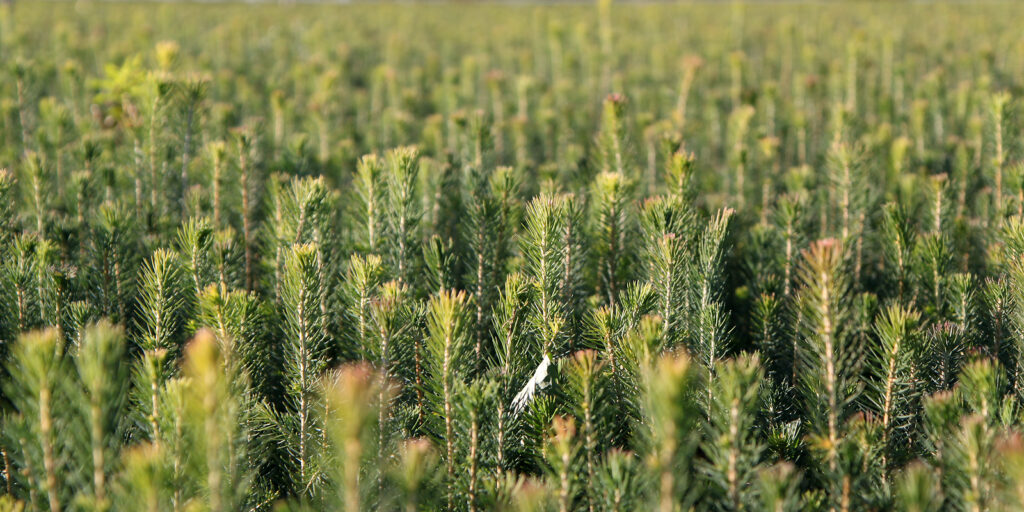Seedlings for coming spring are already packed

Good quality is the minimum criterion for forest tree seedlings. A tree nursery is competitive only if it serves its customers well, say Antti Lännenpää and Jukka Nerg from Fin Forelia.
The last seedlings are being packed for cold storage at the Fin Forelia Tree Nursery in Nurmijärvi. The staff check the quality of the seedlings and the automatic packaging line packs them into cardboard boxes and on to pallets. They are then carted to the cold storage to wait for the busy time in spring.
”The keeps the seedlings healthy and in good condition. Also, we wouldn’t have time to pack them in the spring,” says Mr. Antti Lännenpää, Manager for the Nurmijärvi Nursery.
During the spring season, a veritable truck rally goes on at the tree nursery. One truck can load up to 200,000 forest tree seedlings, and each load has to have the exact right ones: the right species, ages and origins.

“The good quality of the seedlings is the minimum criterion for us. The most important aspect of our work is service, which means that the logistics work as they should. The customer must get the right number of seedlings exactly when they are needed,” Lännenpää explains.
From the viewpoint of logistics, Nurmijärvi is a good location. “The customers are close,” Lännenpää says.
Small wonder, then, that the Nurmijärvi Tree Nursery is being developed. For example, the automatic packaging line was taken into use a year ago.
Every seedling already has a buyer
Not a single seedling is sown in Nurmijärvi until an agreement on its sale has been signed. The old system in nurseries was that half of the amount sown each year was based on orders. The rest were just sold to whoever wanted to buy them.
The current practice means that seedling buyers need to know about two years in advance what will be planted and where. “This can be done because the forest management associations and forest companies have good planning systems and a good understanding of the forest owners’ needs,” says Mr. Jukka Nerg, Head of Production at Fin Forelia.
Fin Forelia is a wholesaler, and it is the company’s customers that sell the seedlings to forest owners. Fin Forelia’s customers include forest companies, forest management associations and Metsähallitus.
New web service to show seedling development
Fin Forelia is developing a new service to enable its customers to better follow the development of the seedlings they have ordered. The service will be launched in spring 2015.
The web-based portal will give the customer access to Fin Forelia’s database to check what is happening to their particular orders. The customer can see what has been sown, how the seedlings have been fertilized and how they grow.

”The customer can see, too, how much of the order has been delivered in each area, when the rest of the seedlings will be delivered, as well as which of them have already been invoiced,” Nerg explains.
In terms of seedling numbers, Fin Forelia is the biggest producer of forest tree seedlings in Finland. It produces about 40 percent of the seedlings planted in Finland.
Small seedlings grow most eagerly
Forest tree seedlings have been grown for decades, but there are still new things to learn about it. The tradition in Finland is to plant big, two-year-old seedlings in forests.
It has been thought that bigger seedlings fare better in the competition for nutrients, space and light. However, the most recent research indicates that in fact, the issue determining the seedling’s success is how well prepared its roots are to start growing.
If a seedling stays too long on a seedling tray, the roots get used to it, and adapting to the new environment in the wild takes longer. Therefore, a smaller and more delicate-looking seedling can actually grow better on a felling site than a bigger one.

In addition, soil preparation methods have developed so much that a large size does not bring relative benefits: grasses can no longer stifle seedlings.
This may not apply when complementing the regeneration of a continuous-cover stand with seedlings. In that case one should probably use bigger seedlings.
Sawdust protects from diseases
The growth of the seedlings is regulated by the availability of water, light and nutrients. The relation of root clump size to seedling height should be just right, so that the seedling gets the best possible start when it is planted in the forest.
Caring for the health of the seedlings starts at sowing. The seeds are sown on a seedling tray filled with fertilized peat and then covered with sawdust.
The sawdust keeps the moisture in the peat more even and the seeds germinate better. ”Some tree nurseries use vermiculite, others sand. We think sawdust is best,” Lännenpää says.
Sawdust is the first step in protecting the seedlings from bacteria and decreasing the need for chemicals, too.
”Seedling diseases are well under control in Finland, thanks to the good cooperation with the Finnish Forest Research Institute,” Nerg says.
Kirjoita kommentti